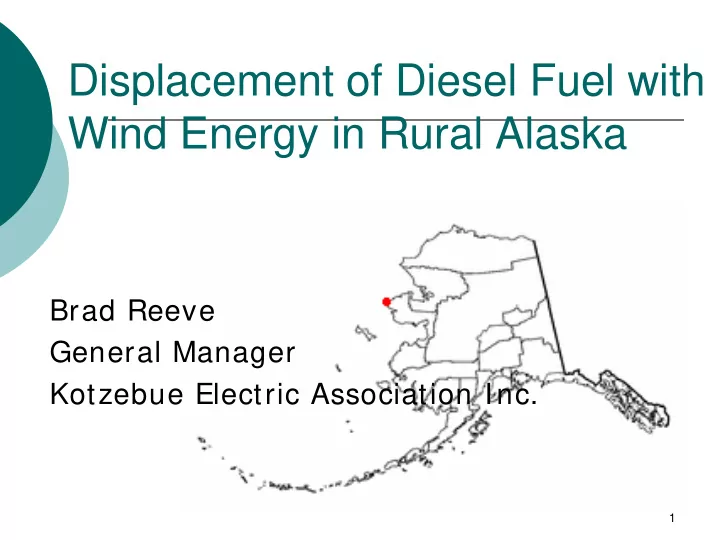

Displacement of Diesel Fuel with Wind Energy in Rural Alaska Brad Reeve General Manager Kotzebue Electric Association Inc. 1
Project Objectives 1. To revitalize and update the technology for the Wales High Penetration Wind-Diesel Power System (HPWDS). 2. To further the understanding of diesel-off HPWDS. 3. To achieve a 50% reduction in diesel fuel consumed for electrical generation. 2 2
ASTF, EPA, KEA - Wales Wind Diesel Project History Funding Sources - KEA, AVEC, ASTF, State of AK., EPA-Innovative Technology Program, NREL Project Scope - to use wind energy to replace diesels electrically and thermally. System uses short term battery storage, rotary converter. A system controller (PLC based) controls the wind turbines, batteries, secondary heat and diesels System has seen 1 5 0 % penetration with wind Excess wind energy keeps diesels warm & heats school 3
ASTF, EPA, KEA - Wales Wind Diesel Project History The project was initiated based upon a grant from the EPA-Innovative Technology Program, procured by NREL KEA was solicited to sponsor the project KEA procured a $450k grant from the Alaska Science and Technology Foundation Deering, Alaska was initially selected as the project site The project was moved to Wales an AVEC utility as Deering would not agree to the grant conditions established by the State of Alaska 4
Wales Power System 5
Power Components in the Wales System (NREL) 6 6
ASTF, EPA, KEA - Wales Wind Diesel Project The project was and is a gateway project that has led to Alaska being view ed as the leader in W ind/ Diesel System s The investigative and research approach to Wales led to considerable breakthroughs in Wind/ Diesel system design and knowledge Without this project system development in Selawik would not have taken place Community Wind/ Diesel development has come from Kotzebue to Wales to Selawik to over 15 community systems 7
ASTF, EPA, KEA - Wales Wind Diesel Project The project currently is viewed as a failure . At the recently sponsored UAF/ ACEP Wind Diesel Conference the participants ranked the re-establishment of the Wales project as # 1 The grant being asked for would update the controller system to remove operational and communication road-blocks that have caused the project to not run as envisioned. With a relatively small investment this project can again contribute to the knowledge needed to project solutions for future high penetration projects. 8
Initial Overlying Questions Is wind an appropriate technology for Alaska and especially rural Alaska How does wind technology fit into Alaska What does it take to make wind work What does the future hold for wind technology 9
History of Wind Development in Alaska In the early 1980’s there were 140 state and federally sponsored wind generators installed across Alaska The vast majority were out of commission within a year. Wind was seen as unreliable and the technology was abandoned in Alaska. 10
Enertech 1800 - Wales
Many Initial Questions Were Answered Is the equipment better ? Do we know more ? Do we have a better understanding of the resource ? Is utility involvement important ? Are manufacturers more attuned to cold weather conditions 12
Why (AOC) now Entegrity? Alaska needed a machine that would work in the cold, and smaller villages Predecessor of the AOC was the Enertech 14/ 40, a highly dependable machine developed in the 1970’s that is still in use in California The AOC 15/ 50 was developed from a Failure Mode Analysis of the Enertech 14/ 40 The AOC 15/ 50 was refined through the Advanced Turbine Design program at NREL 13
14
Wales Alaska Located at the Tip of Seward Peninsula 15
Project Construction 16
Arctic Foundations 17
Tilt Up Towers 18
Wales Alaska
Soils Analysis/Foundations - Wales
Shipping - Wales
On Site Construction - Wales
Mounting Drive Train - Wales
Turbine Erection - Wales
Gin Pole - Wales
Turbines Installed - Wales
Wind Turbine Control Building - Wales
Wind Turbine Control Panels - Wales
System Controller - Wales
Energy Storage System (ESS) Building - Wales
Secondary Heat - Wales School
Secondary Heat - Wales Power Plant
Boiler - Wales Power Plant
Lessons Learned The system had to be converted from single phase to 3 phase Modifications to the diesel plant fuel system were needed Diesel generators were not pitched the same, one was replaced Modifications to diesel plant cooling system were needed NREL Testing of system continued for several years 34
What Worked Wind turbines have been operational for 4 years Recovered heat boilers operated at the school and the diesel plant The system controller is operational in 3 modes Battery bank and rotary converter are operational 35
Project planning, lessons learned Packaging for air/ barge shipment is critical Minimal or no crane capability - Tilt up Towers Cold weather materials and features Coincidence of extreme cold and good wind can dramatically increase turbine output Winter maintenance is extremely challenging and at times impossible Staging of spare parts must be carefully evaluated Comprehensive training of local utility and/ or operations personnel is essential to success 36
Wales Results to Date Initial project operational on and off since 2001 With 2 operational turbines there has been 150% penetration with no negative effect to system Project ran diesels off for several hundred hours Many lessons learned that lead to cost reductions at other locations 37
Data Analysis Install satellite equipment to ensure remote connectivity. Specific issues will be highlighted 1. Data logging of plat operations. 2. Wind turbine output 3. Performance problems. 4. Component failures 5. Power quality. 38 38
Looking Forward Alaska has 2 high penetration systems Wales is the only community system in Alaska that is able to run in a diesel-off mode. Many proposed wind-diesel systems have the potential to be high penetration To advance high penetration systems Wales MUST be updated to incorporate modern technology to enable a greater understanding of these systems. 39 39
Recommend
More recommend